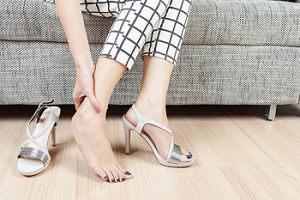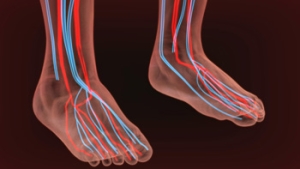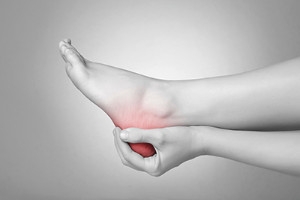
The Harm in High Heels
 High heels are a wardrobe staple for many, however, wearing high heels can have serious consequences for foot health. A study on foot and ankle injuries in the U.S. found that between 2002 and 2012, U.S. emergency rooms treated 123,355 high heel-related injuries. Strains and sprains of the foot and ankle were the most common of these injuries, and about 20% of them involved broken bones. Another study, this time looking at South Korean flight attendants who were required to wear high heels daily for work, found that their balance decreased over time due to a loss of strength in the muscles and tendons that support the front-to-back movement of the foot. If you do wear high heels, it is recommended that you wear them less frequently, and that you give your feet a break by taking the high heels off to stretch your feet and ankles or by switching to running shoes. For more information on the connection between footwear and foot health, speak with a podiatrist today.
High heels are a wardrobe staple for many, however, wearing high heels can have serious consequences for foot health. A study on foot and ankle injuries in the U.S. found that between 2002 and 2012, U.S. emergency rooms treated 123,355 high heel-related injuries. Strains and sprains of the foot and ankle were the most common of these injuries, and about 20% of them involved broken bones. Another study, this time looking at South Korean flight attendants who were required to wear high heels daily for work, found that their balance decreased over time due to a loss of strength in the muscles and tendons that support the front-to-back movement of the foot. If you do wear high heels, it is recommended that you wear them less frequently, and that you give your feet a break by taking the high heels off to stretch your feet and ankles or by switching to running shoes. For more information on the connection between footwear and foot health, speak with a podiatrist today.
High heels have a history of causing foot and ankle problems. If you have any concerns about your feet or ankles, contact Dr. Stephen Petrofsky from Florida. Our doctor can provide the care you need to keep you pain-free and on your feet.
Effects of High Heels on the Feet
High heels are popular shoes among women because of their many styles and societal appeal. Despite this, high heels can still cause many health problems if worn too frequently.
Which Parts of My Body Will Be Affected by High Heels?
- Ankle Joints
- Achilles Tendon – May shorten and stiffen with prolonged wear
- Balls of the Feet
- Knees – Heels cause the knees to bend constantly, creating stress on them
- Back – They decrease the spine’s ability to absorb shock, which may lead to back pain. The vertebrae of the lower back may compress.
What Kinds of Foot Problems Can Develop from Wearing High Heels?
- Corns
- Calluses
- Hammertoe
- Bunions
- Morton’s Neuroma
- Plantar Fasciitis
How Can I Still Wear High Heels and Maintain Foot Health?
If you want to wear high heeled shoes, make sure that you are not wearing them every day, as this will help prevent long term physical problems. Try wearing thicker heels as opposed to stilettos to distribute weight more evenly across the feet. Always make sure you are wearing the proper shoes for the right occasion, such as sneakers for exercising. If you walk to work, try carrying your heels with you and changing into them once you arrive at work. Adding inserts to your heels can help cushion your feet and absorb shock. Full foot inserts or metatarsal pads are available.
If you have any questions please feel free to contact our office located in Port Charlotte, FL . We offer the newest diagnostic and treatment technologies for all your foot and ankle needs.
Effect of High Heels on the Feet
High heels are uncomfortable, but many women sacrifice comfort to be stylish. There are many problems that stem from wearing high heels, however these issues can be avoided by wearing proper shoes.
Heels are bad because they push your weight forward toward the fall of the foot. The higher the heel is, the more weight and pressure get shifted. This process causes the back to hyperextend backwards to counterbalance which may cause pain in the leg, hip, and back. Consequently, major posture problems may occur, and these issues may eventually become permanent.
Wearing high heels is one of the leading cause of ingrown toenails. Heels create a great deal of pressure on the big toenails which disrupts proper toenail growth. This may eventually lead to the big toenail growing into the skin. Another common problem that stems from high heels is bunions. If bunions go untreated, they can cause serious scar tissue to form along with severe pain.
However, there are ways to minimize the harmful risks associated with wearing heels. You should try to massage and stretch your legs and feet after wearing heels for an extended time. Stretching helps prevent the Achilles tendons and calf muscles from becoming too tight. A good substitute for heels are platforms which provide a better surface area to evenly distribute the body’s weight.
If you are experiencing any painful foot conditions from wearing high heels, you should consult with your podiatrist right away.
Reasons for Reconstructive Foot Surgery
 Foot reconstruction is a type of surgery that is performed to correct the anatomy of the foot and restore proper function. Someone might need reconstructive foot surgery following a major injury to the foot that affects the foot’s soft tissue or bones. Vascular diseases, which can interfere with circulation in the lower limbs, may require surgical intervention. Other issues which can cause deformities include metabolic diseases, such as diabetes and gout, that alter the blood and nerve supply of the foot, and tumors. Finally, birth defects such as clubfoot would also need to be corrected via reconstructive surgery. For more information on reconstructive foot surgery, please consult with a podiatrist.
Foot reconstruction is a type of surgery that is performed to correct the anatomy of the foot and restore proper function. Someone might need reconstructive foot surgery following a major injury to the foot that affects the foot’s soft tissue or bones. Vascular diseases, which can interfere with circulation in the lower limbs, may require surgical intervention. Other issues which can cause deformities include metabolic diseases, such as diabetes and gout, that alter the blood and nerve supply of the foot, and tumors. Finally, birth defects such as clubfoot would also need to be corrected via reconstructive surgery. For more information on reconstructive foot surgery, please consult with a podiatrist.
Foot surgery is sometimes necessary to treat a foot ailment. To learn more, contact Dr. Stephen Petrofsky of Florida. Our doctor will assist you with all of your foot and ankle needs.
When Is Surgery Necessary?
Foot and ankle surgery is generally reserved for cases in which less invasive, conservative procedures have failed to alleviate the problem. Some of the cases in which surgery may be necessary include:
- Removing foot deformities like bunions and bone spurs
- Severe arthritis that has caused bone issues
- Cosmetic reconstruction
What Types of Surgery Are There?
The type of surgery you receive will depend on the nature of the problem you have. Some of the possible surgeries include:
- Bunionectomy for painful bunions
- Surgical fusion for realignment of bones
- Neuropathy decompression surgery to treat nerve damage
Benefits of Surgery
Although surgery is usually a last resort, it can provide more complete pain relief compared to non-surgical methods and may allow you to finally resume full activity.
Surgical techniques have also become increasingly sophisticated. Techniques like endoscopic surgery allow for smaller incisions and faster recovery times.
If you have any questions please feel free to contact our office located in Port Charlotte, FL . We offer the newest diagnostic and treatment technologies for all your foot and ankle needs.
Foot Surgery
In most cases, foot surgery is often chosen as the last available option for conditions that have otherwise been unsuccessfully treated. Surgery may be necessary for several reasons, including the removal of foot deformities (e.g. bone spurs or bunions), arthritis problems, reconstruction due to injury, and congenital malformations (e.g. club foot or flat feet). Regardless of one’s age, foot surgery may be the only successful option for treatment for certain conditions.
The type of surgery one undergoes depends on the type of foot condition the patient has. For the removal of a bunion growth, a bunionectomy is necessary. If the bones in the feet need to be realigned or fused together, a surgical fusion of the foot is needed. For pain or nerve issues, a patient may require surgery in which the tissues surrounding the painful nerve are removed. Initially, less invasive treatments are generally attempted; surgery is often the last measure taken if other treatments are unsuccessful.
While in many cases surgery is often deemed as the final resort, choosing surgery comes with certain benefits. The associated pain experienced in relation to the particular condition is often relieved with surgery, allowing patients to quickly resume daily activities. The greatest benefit, however, is that surgery generally eliminates the problem immediately.
Podiatry history has shown that foot treatments continue to evolve over time. In the field of foot surgery, endoscopic surgery is just one of the many advanced forms of surgery. As technology vastly improves so too will the various techniques in foot surgery, which already require smaller and smaller incisions with the use of better and more efficient tools. Thanks to such innovations, surgery is no longer as invasive as it was in the past, allowing for faster and easier recoveries.
Who May Be More Prone to Peripheral Artery Disease?
Peripheral artery disease ( PAD) is a condition that causes poor blood flow to the lower extremities. This is due to a buildup of plaque along the walls of the arteries, causing them to narrow and become stiff and thus restricting blood flow. According to a recent study, people with rheumatoid arthritis (RA), an autoimmune disorder that affects the joints, appear to be at an increased risk of developing PAD. Fortunately, both PAD and RA can be managed. A podiatrist can screen for PAD and recommend treatment options for both conditions. If you have poor circulation to your lower limbs or arthritic joint pain in your feet and ankles, it is suggested that you consult with a podiatrist.
PAD) is a condition that causes poor blood flow to the lower extremities. This is due to a buildup of plaque along the walls of the arteries, causing them to narrow and become stiff and thus restricting blood flow. According to a recent study, people with rheumatoid arthritis (RA), an autoimmune disorder that affects the joints, appear to be at an increased risk of developing PAD. Fortunately, both PAD and RA can be managed. A podiatrist can screen for PAD and recommend treatment options for both conditions. If you have poor circulation to your lower limbs or arthritic joint pain in your feet and ankles, it is suggested that you consult with a podiatrist.
Peripheral artery disease can pose a serious risk to your health. It can increase the risk of stroke and heart attack. If you have symptoms of peripheral artery disease, consult with Dr. Stephen Petrofsky from Florida. Our doctor will assess your condition and provide you with quality foot and ankle treatment.
Peripheral artery disease (PAD) is when arteries are constricted due to plaque (fatty deposits) build-up. This results in less blood flow to the legs and other extremities. The main cause of PAD is atherosclerosis, in which plaque builds up in the arteries.
Symptoms
Symptoms of PAD include:
- Claudication (leg pain from walking)
- Numbness in legs
- Decrease in growth of leg hair and toenails
- Paleness of the skin
- Erectile dysfunction
- Sores and wounds on legs and feet that won’t heal
- Coldness in one leg
It is important to note that a majority of individuals never show any symptoms of PAD.
Diagnosis
While PAD occurs in the legs and arteries, Podiatrists can diagnose PAD. Podiatrists utilize a test called an ankle-brachial index (ABI). An ABI test compares blood pressure in your arm to you ankle to see if any abnormality occurs. Ultrasound and imaging devices may also be used.
Treatment
Fortunately, lifestyle changes such as maintaining a healthy diet, exercising, managing cholesterol and blood sugar levels, and quitting smoking, can all treat PAD. Medications that prevent clots from occurring can be prescribed. Finally, in some cases, surgery may be recommended.
If you have any questions, please feel free to contact our office located in Port Charlotte, FL . We offer the newest diagnostic and treatment technologies for all your foot care needs.
Peripheral Artery Disease
Peripheral artery disease (PAD), or peripheral arterial disease, is a circulatory problem in which there is a reduction of blood flow to the limbs due to narrowed arteries. When peripheral artery disease develops, the extremities do not receive enough blood flow; this may cause symptoms to develop such as claudication, or leg pain when walking. The legs are the most common site of peripheral artery disease.
Claudication, or leg pain when walking, is one of several symptoms that can develop due to peripheral artery disease. Other symptoms caused by the disease include painful cramping in the hips, thighs, or calves after certain activities; leg numbness or weakness; coldness in the lower leg or foot; sores on the lower extremities that do not heal; hair loss on the lower extremities; and a missing or weak pulse in the lower extremities. In more severe cases, pain may even occur when the body is at rest or when lying down.
Peripheral artery disease is typically caused by atherosclerosis, a condition in which fatty deposits build up in the arterial walls and reduce blood flow. Smoking, diabetes, obesity, high blood pressure, and high cholesterol are some of the risk factors for peripheral artery disease.
If you are experiencing pain, numbness, or other symptoms in the lower extremities, see your healthcare professional immediately. Diagnosed peripheral artery disease can be treated with various medications, angioplasty and surgery, exercise programs, or alternative medicine. It is important to consult a healthcare professional to determine the best treatment for you.
How Can I Prevent Running Injuries?
 Injury to the foot and ankle can be common among runners. Fortunately, there are steps you can take to help prevent injuries. It is said when you first start running, build up your training regimen slowly, increasing the amount of time and distance that you run at a very gradual pace. Allow your body and feet adequate time to adjust, as well as rest and heal. It is also important to develop a good running technique. This can be accomplished through running lessons, where an instructor can teach you about proper foot placement and other techniques to ensure that you stay safe while you run. Finally, make sure that you wear supportive, properly-fitted running shoes when you exercise. For more advice on preventing running injuries, consult with a podiatrist today.
Injury to the foot and ankle can be common among runners. Fortunately, there are steps you can take to help prevent injuries. It is said when you first start running, build up your training regimen slowly, increasing the amount of time and distance that you run at a very gradual pace. Allow your body and feet adequate time to adjust, as well as rest and heal. It is also important to develop a good running technique. This can be accomplished through running lessons, where an instructor can teach you about proper foot placement and other techniques to ensure that you stay safe while you run. Finally, make sure that you wear supportive, properly-fitted running shoes when you exercise. For more advice on preventing running injuries, consult with a podiatrist today.
Exercising your feet regularly with the proper foot wear is a great way to prevent injuries. If you have any concerns about your feet, contact Dr. Stephen Petrofsky of Florida. Our doctor will treat your foot and ankle needs.
How to Prevent Running Injuries
Many common running injuries are caused by overuse and overtraining. When the back of the kneecap starts wearing out and starts causing pain in your knee, this is commonly referred to as runner’s knee. Runner’s knee is a decrease in strength in your quadriceps and can occur if you’re not wearing properly fitted or supporting shoes. To prevent runner’s knee, focusing on hip strengthening is a good idea, as well as strengthening your quads to keep the kneecaps aligned.
What Are Some Causes of Running Injuries?
- One cause of a common running injury is called iliotibial band syndrome.
- Plantar fasciitis is also another common injury.
- Stress fractures can occur from overtraining, lack of calcium, or even your running style.
Best Ways to Prevent Running Injuries
- Wear footwear that fits properly and suits your running needs.
- Running shoes are the only protective gear that runners have to safeguard them from injury.
- Make a training schedule. Adding strengthening exercises as well as regular stretching can help keep you strong and limber and can lessen the possibility of injuries.
- Stretching keeps muscles limber; this will help you gain better flexibility.
If you have any questions please feel free to contact our office located in Port Charlotte, FL . We offer the newest diagnostic and treatment technologies for all your foot and ankle needs.
How to Prevent Running Injuries
Overtraining and overusing the feet are the main causes of common running injuries. A number of these common injuries are caused by overrunning. Runner’s knee is a condition that is characterized by the back of the kneecap beginning to wear away and cause pain in the knee. This frequently occurs due to either a decrease in strength in the quadriceps muscles or ill-fitting shoes that are lacking in proper support for the inside of the forefoot. Strengthening exercises focusing on the quad muscle and sports orthotics are the usual treatments for those suffering from runner’s knee. Prevention of the condition lies in a focus on hip strengthening and quad-strengthening to keep the kneecap aligned. To help learn the best exercise to heal runner’s knee, one can also undergo physical therapy.
One common injury, called iliotibial band syndrome, is often caused by overtraining. This condition occurs when the iliotibial band gets irritated, creating pain and discomfort in the outside knee area. Plantar fasciitis, another common running injury, also occurs as a result of inflammation and irritation. Plantar fasciitis is an inflammation and irritation of the bone in the foot. A large amount of pain is often experienced due to plantar fasciitis. The condition can be caused by a high arch, improper footwear, tight muscles, or flat feet. It can best be avoided by stretching and wearing appropriate footwear that supports the foot.
Another common injury for runners is stress fractures. These injuries occur due to running style, overtraining, or a lack of calcium. Stress fractures most often occur in several locations in runners, including the inner bone of the leg, the thighbone, the bone at the base of the spine and the bones of the toes. Stress fractures are best prevented by wearing proper footwear and by running on flat and hard surfaces; this will absorb some of the shock created during running.
Aside from overtraining, other causes of common running injuries include ill-fitting footwear, a lack of flexibility and strength, and irregular biomechanics. The best way to avoid running injuries is to prevent them from even occurring. Both iliotibial band syndrome and stress fractures are preventable. The first step that should be taken to prevent running injuries is to only wear footwear that fits properly and that is appropriate for whatever activity you are doing. Running shoes are the only protective gear available to runners that can safeguard them from sustaining injuries. Choosing the right pair of shoes is therefore extremely important. While running shoes are an important factor, it is also important to consider other facets of your running routine such as training schedules, flexibility, and strengthening. These elements should be considered and altered according to your running needs to best maximize your run and minimize the possibility of injury. Careful stretching before and after a run should also be considered to help prevent running injuries. Stretching muscles enables greater flexibility and a lesser chance of sustaining injury.
Sever’s Disease: An Overuse Injury
 Sever’s disease, also known as calcaneal apophysitis, is not a disease at all, but rather an overuse injury. This condition affects the growth plate of the heel bone and is therefore most common in children and teenagers who are still rapidly growing. Sever’s disease causes inflammation in the heel, stiffness in the foot, and pain when standing, walking, running or jumping that usually improves with rest. Children who are involved in sports are the most at risk for developing Sever’s disease because they put frequent, repetitive pressure on the heel. Other risk factors for developing this condition include wearing ill-fitting shoes, having flat arches or pronated feet, and obesity. If your child is experiencing heel pain and stiffness, it is recommended that you take them to a podiatrist for treatment.
Sever’s disease, also known as calcaneal apophysitis, is not a disease at all, but rather an overuse injury. This condition affects the growth plate of the heel bone and is therefore most common in children and teenagers who are still rapidly growing. Sever’s disease causes inflammation in the heel, stiffness in the foot, and pain when standing, walking, running or jumping that usually improves with rest. Children who are involved in sports are the most at risk for developing Sever’s disease because they put frequent, repetitive pressure on the heel. Other risk factors for developing this condition include wearing ill-fitting shoes, having flat arches or pronated feet, and obesity. If your child is experiencing heel pain and stiffness, it is recommended that you take them to a podiatrist for treatment.
Sever's disease often occurs in children and teens. If your child is experiencing foot or ankle pain, see Dr. Stephen Petrofsky from Florida. Our doctor can treat your child’s foot and ankle needs.
Sever’s Disease
Sever’s disease is also known as calcaneal apophysitis, which is a medical condition that causes heel pain I none or both feet. The disease is known to affect children between the ages of 8 and 14.
Sever’s disease occurs when part of the child’s heel known as the growth plate (calcaneal epiphysis) is attached to the Achilles tendon. This area can suffer injury when the muscles and tendons of the growing foot do not keep pace with bone growth. Therefore, the constant pain which one experiences at the back of the heel will make the child unable to put any weight on the heel. The child is then forced to walk on their toes.
Symptoms
Acute pain – Pain associated with Sever’s disease is usually felt in the heel when the child engages in physical activity such as walking, jumping and or running.
Highly active – Children who are very active are among the most susceptible in experiencing Sever’s disease, because of the stress and tension placed on their feet.
If you have any questions, please feel free to contact our office located in Port Charlotte, FL . We offer the newest diagnostic and treatment technologies for all your foot and ankle injuries.















